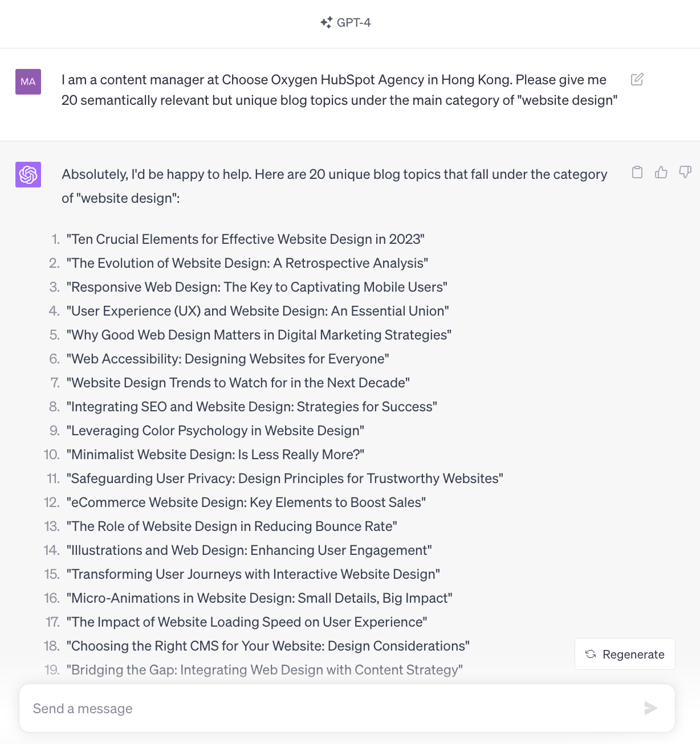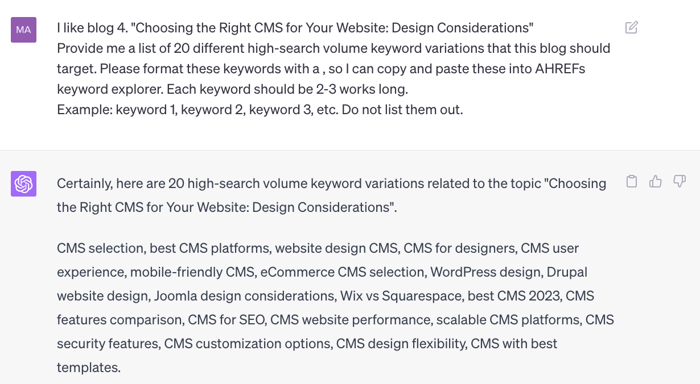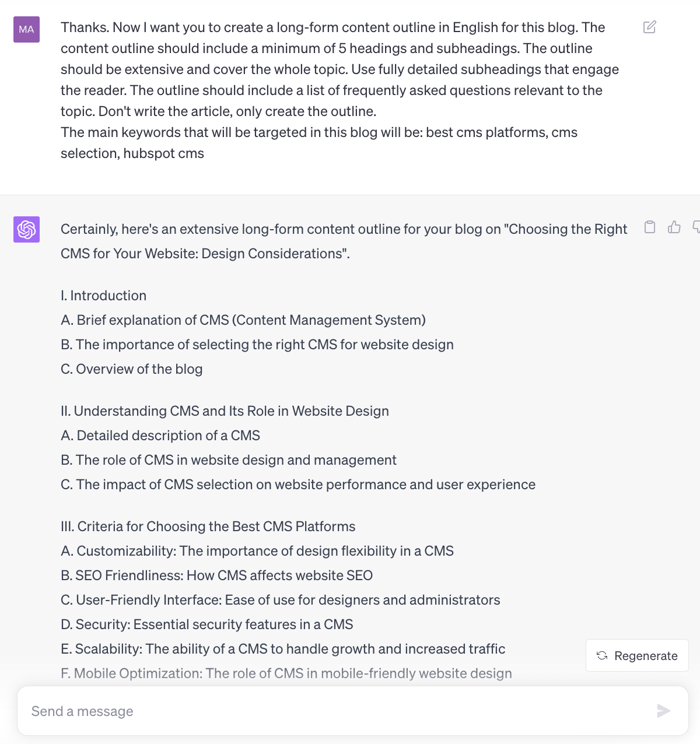Embracing the latest trends in digital marketing is crucial for any business looking to stay ahead. One of the most transformative developments in recent months is the integration of ChatGPT in various business processes, especially SEO. In our recent exploration on ChatGPT's key use cases for businesses, we highlighted content creation and SEO as the prime application, ranking it at #1. When harnessed correctly, ChatGPT can empower you to produce SEO-friendly content in just a matter of minutes.
This guide provides a step-by-step process on how to utilise ChatGPT for crafting blog posts that can rank #1 on Google. We'll illustrate with examples and prompts to set you on the right path.
Step 1: GPT-4 for Blog Ideation and Title Ideation
Before diving into keyword research, the first step in creating a compelling, SEO-friendly blog post is coming up with a blog title that will resonate with your audience. When you're lost in the sea of potential topics, you can simply ask ChatGPT for a list of topics in your niche. It's like having your personal SEO research assistant.
Here is an example of the prompt we used to get ChatGPT to come up with some blog ideas about "website design":

And just like that, we have a list of 20 semantically relevant blog topics to choose from.
Step 2: GPT-4 for Keyword Research
Keyword research forms the backbone of any successful SEO strategy. By requesting ChatGPT to generate a list of keywords related to a specific topic, you can quickly populate a list of relevant terms and then use a SEO tool like AHREFs to check the difficulty and traffic potential to choose then the best ones to use in your blog.
Continuing from the same example as above, I picked one of the 20 suggested blog titles provided by ChatGPT and prompted it to generate keywords and phrases related to this topic. The full prompt can be seen in the screenshot below:

ChatGPT can also identify Latent Semantic Indexing (LSI) keywords, which are thematically linked to your main keyword. These expand the scope of your content and increase its visibility on search engines.
Long-tail keywords—longer, more specific phrases that users are likely to use when nearing a purchase—are another crucial aspect of keyword research. For instance, 'digital marketing trends in B2B sectors' is a long-tail keyword for 'digital marketing trends'. Similarly, synonyms help cater to different search queries, for example, 'online marketing trends' or 'internet marketing innovations'.
Step 3: Crafting SEO-friendly Blog Outlines with GPT-4
An SEO-friendly blog outline is your roadmap to a coherent and comprehensive blog post. It ensures that you cover all relevant subtopics and incorporate your keywords in a natural, effective way. With your main topic and generated keywords, you can request GPT-4 to create an outline.

After ChatGPT generates the initial structure, you should provide feedback. Let it know what you like and what you don’t like. Don’t just edit outside and keep changes to yourself. Keep the conversation going, it may take several steps to get this right.
Step 4: Guiding GPT-4 to Write the Blog Post Using the New Code Interpreter Feature
One of the standout features of ChatGPT is its new code interpreter capability. For blog writing, this feature is super useful, as it can allow you to upload your brand book guidelines or tone of voice document, enabling ChatGPT to generate content that aligns perfectly with your brand's voice and style. By providing this model with precise guidelines, you're ensuring that the output is tailored to your brand's identity.
.png?width=1286&height=882&name=Screenshot-2023-08-07-at-10.36.56-AM-(1).png)
When executed correctly, by giving GPT-4 the right parameters, examples, and desired structure, you can produce top-notch long-form content with just a single prompt. The efficiency and accuracy of this process can significantly reduce the time and effort traditionally associated with content creation.
Mastering ChatGPT to Write #1 Ranking Blogs: The Oxygen Approach
Mastering the art of producing high-quality, SEO-friendly content using ChatGPT isn't just about leveraging the tool—it's about the finesse of clear instructions, understanding the nuances of your brand's tone of voice, and continuously refining your approach. The process requires iteration; testing, retesting, and understanding the nuances of how ChatGPT interprets instructions.
At Oxygen, we've been through this journey, navigating the challenges and unlocking the potential of ChatGPT for content creation. Through our experiences, we've distilled our learnings into a robust 7-step process that trains ChatGPT to write with the exact style, tone of voice, and level of quality we expect. The intricacies of this process, filled with insights and actionable strategies, will be unveiled in an upcoming blog post. Stay tuned to discover how we've honed the art and science of content creation with ChatGPT.
 UAE/GCC
UAE/GCC International
International![How to Use ChatGPT to Write Blog Posts That Rank #1 On Google [Step-by-Step Guide + Example Prompts] featured image](https://www.chooseoxygen.com/hs-fs/hubfs/How%20to%20Use%20ChatGPT%20to%20Write%20Blog%20Posts%20That%20Rank%20%231%20On%20Google%20%5BStep-by-Step%20Guide%20+%20Example%20Prompts%5D.jpg?width=800&name=How%20to%20Use%20ChatGPT%20to%20Write%20Blog%20Posts%20That%20Rank%20%231%20On%20Google%20%5BStep-by-Step%20Guide%20+%20Example%20Prompts%5D.jpg)










